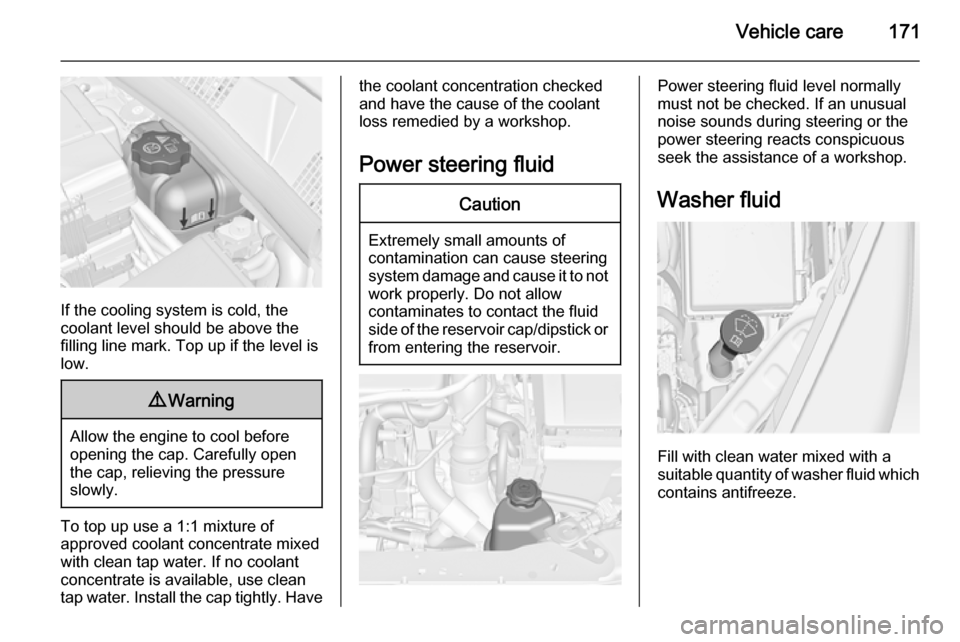2015 VAUXHALL MERIVA power steering
[x] Cancel search: power steeringPage 13 of 245

In brief11
1Power windows .....................30
2 Exterior mirrors .....................28
3 Cruise control .....................149
4 Side air vents ...................... 131
5 Turn and lane-change
signals, headlight flash,
low beam and high beam ...119
Exit lighting ......................... 122
Parking lights ...................... 120
Driver Information Centre ...... 99
6 Instruments .......................... 88
7 Steering wheel controls .......81
8 Driver Information Centre ...... 99
9 Windscreen wiper,
windscreen washer
system, rear wiper, rear
washer system .....................83
10 Centre air vents .................. 131
11 Central locking system ..........21
Hazard warning flashers ....119
Control indicator for airbag
deactivation .......................... 94
12 Info-Display ......................... 10213Sensor for electronic
climate control system .......126
14 Glovebox .............................. 61
Fuse box ............................ 188
15 Traction Control system .....148
Electronic Stability Control . 148
Ultrasonic parking assist ....151
Eco button ........................... 137
Fuel selector ......................... 90
16 Climate control system ........ 124
17 Selector lever, manual
transmission ....................... 144
Automatic transmission ......141
18 Electrical parking brake ......146
19 Ignition switch with
steering wheel lock ............135
20 Horn ..................................... 82
Driver airbag ........................ 51
21 Bonnet release lever ..........169
22 Storage compartment ...........61
23 Steering wheel adjustment ..8124 Light switch ........................ 115
Headlight range
adjustment ......................... 117
Front fog lights ...................119
Rear fog light ...................... 120
Instrument illumination .......121
Page 107 of 245

Instruments and controls105
No.Vehicle message6Depress brake pedal to release
electrical parking brake7Turn steering wheel, switch
ignition off and then on9Turn steering wheel, start
engine again12Vehicle overloaded13Compressor overheated15Centre high-mounted brake
light failure16Brake light failure17Headlight levelling malfunction18Left low beam failure19Rear fog light failure20Right low beam failure21Left sidelight failure22Right sidelight failure23Reversing light failureNo.Vehicle message24Number plate light failure25Left front turn signal failure26Left rear turn signal failure27Right front turn signal failure28Right rear turn signal failure29Check trailer brake light30Check trailer reversing light31Check left trailer turn signal32Check right trailer turn signal33Check trailer rear fog light34Check trailer rear light35Replace battery in radio remote
control48Clean side blind zone alert
system53Tighten gas cap54Water in diesel fuel filterNo.Vehicle message55Diesel particle filter is full
3 14056Tyre pressure imbalance on
front axle57Tyre pressure imbalance on
rear axle58Tyres without TPMS sensors
detected59Open and then close driver
window60Open and then close front
passenger window61Open and then close rear left
window62Open and then close rear right
window65Theft attempted66Service theft alarm system67Service steering wheel lock68Service power steering
Page 136 of 245

134Driving and operatingDriving and operatingDriving hints............................... 134
Starting and operating ...............135
Engine exhaust .......................... 140
Automatic transmission .............. 141
Manual transmission ..................144
Brakes ........................................ 145
Ride control systems .................148
Driver assistance systems .........149
Fuel ............................................ 155
Trailer hitch ................................ 162Driving hints
Control of the vehicleNever coast with engine not
running (except during Autostop)
Many systems will not function in this
situation (e.g. brake servo unit, power steering). Driving in this manner is a
danger to yourself and others. All
systems function during an Autostop,
but there will be a controlled reduction
in power steering assist and vehicle
speed is reduced.
Stop-start system 3 137.
Idle boost
If charging of the vehicle battery is
required due to vehicle battery
condition, the power output of the
generator must be increased. This will be achieved by an idle boost which
may be audible.
On vehicles with Uplevel-Display or
Uplevel-Combi-Display, a message
appears in the Driver Information
Centre.Pedals
To ensure the pedal travel is
uninhibited, there must be no mats in
the area of the pedals.
Steering If power steering assist is lost
because the engine stops or due to a system malfunction, the vehicle can
be steered but may require a higher
or lower steering effort.
Control indicator c 3 96.Caution
Vehicles equipped with hydraulic
power steering:
If the steering wheel is turned until it reaches the end of its travel, and
is held in that position for more
than 15 seconds, damage may
occur to the power steering
system and there may be loss of
power steering assist.
Page 137 of 245

Driving and operating135Starting and operating
New vehicle running-in Do not brake unnecessarily hard for
the first few journeys.
During the first drive, smoke may
occur because of wax and oil
evaporating off the exhaust system.
Park the vehicle in the open for a
while after the first drive and avoid
inhaling the fumes.
During the running-in period fuel and
engine oil consumption may be
higher and the cleaning process of the diesel particle filter may take
place more often. Autostop may be inhibited to allow for charging the
vehicle battery.
Diesel particle filter 3 140.Ignition switch positions0=Ignition off1=Steering wheel lock released,
ignition off2=Ignition on, for diesel engine:
preheating3=Starting
Retained power off
The following electronic systems can
work until the driver's door is opened
or at the latest for 10 minutes after the
ignition is switched off:
■ Power windows
■ Power outlets
Power to the Infotainment system will continue to operate for 30 minutes oruntil the key is removed from the
ignition, regardless of whether any
door will be opened.
Starting the engine
Manual transmission: operate clutch.
Automatic transmission: operate
brake and move the selector lever to
P or N.
Do not operate accelerator pedal.
Page 141 of 245

Driving and operating139
■ the engine temperature is too low
■ the vehicle battery is discharged
■ the brake vacuum is not sufficient
■ the vehicle starts to move
■ the climate control system requests
an engine start
■ the air conditioning is manually switched on
If the bonnet is not fully closed, a
warning message is displayed in the
Driver Information Centre.
If an electrical accessory, e.g. a
portable CD player, is connected to
the power outlet, a brief power drop
during restart might be noticeable.
Parking9 Warning
■ Do not park the vehicle on an
easily ignitable surface. The
high temperature of the exhaust system could ignite the surface.
■ Always apply parking brake.
Pull switch m for approx.
one second.
The electric parking brake is
applied when control indicator
m illuminates 3 95.
■ Switch off the engine.
■ If the vehicle is on a level surface or uphill slope, engage
first gear or set the selector lever to position P before removing
the ignition key. On an uphill
slope, turn the front wheels
away from the kerb.
If the vehicle is on a downhill
slope, engage reverse gear or
set the selector lever to position
P before removing the ignition
key. Turn the front wheels
towards the kerb.
■ Remove the ignition key. Turn the steering wheel until the
steering wheel lock is felt to
engage.
For vehicles with automatic
transmission, the key can onlybe removed when the selector
lever is in position P.
Lock the vehicle and activate the anti-
theft alarm system.
Notice
In the event of an accident with
airbag deployment, the engine is
turned off automatically if the vehicle
comes to a standstill within a certain
time.
Page 164 of 245

162Driving and operatingTrailer hitch
General information
Only use towing equipment that has
been approved for your vehicle.
Entrust retrofitting of towing
equipment to a workshop. It may be
necessary to make changes that
affect the cooling system, heat
shields or other equipment.
Fitting of towing equipment could
cover the opening of the towing eye.
If this is the case use the coupling ball
bar for towing. Always keep the
coupling ball bar in the vehicle.
Driving characteristics and
towing tips
Before attaching a trailer, lubricate
the coupling ball. However, do not do
so if a stabiliser, which acts on the coupling ball, is being used to reduce snaking movements.
For trailers with low driving stability
and caravan trailers with a permitted
gross vehicle weight of more than1100 kg the use of a stabiliser is
strongly recommended when driving
above 50 mph.
If the trailer starts snaking, drive more slowly, do not attempt to correct the
steering and brake sharply if
necessary.
When driving downhill, drive in the
same gear as if driving uphill and
drive at a similar speed.
Adjust tyre pressure to the value
specified for full load 3 232.
Trailer towing Trailer loads9 Warning
Vehicles with engine A13DTE:
Use of towing equipment is
permissible for attaching
compatible bicycle carriers only.
Do not use towing equipment for
trailer towing.
The permissible trailer loads are
vehicle and engine-dependent
maximum values which must not be
exceeded. The actual trailer load is
the difference between the actual
gross weight of the trailer and the
actual coupling socket load with the
trailer coupled.
The permissible trailer loads are
specified in the vehicle documents. In general, they are valid for gradients
up to max. 12 %.
The permitted trailer load applies up to the specified incline and up to an
altitude of 1000 metres above sea
level. Since engine power decreases
as altitude increases due to the air becoming thinner, therefore reducing
climbing ability, the permissible gross
train weight also decreases by 10 %
for every 1000 metres of additional
altitude. The gross train weight does
not have to be reduced when driving
on roads with slight inclines (less than
8 %, e.g. motorways).
Page 173 of 245

Vehicle care171
If the cooling system is cold, the
coolant level should be above the
filling line mark. Top up if the level is
low.
9 Warning
Allow the engine to cool before
opening the cap. Carefully open
the cap, relieving the pressure
slowly.
To top up use a 1:1 mixture of
approved coolant concentrate mixed
with clean tap water. If no coolant
concentrate is available, use clean
tap water. Install the cap tightly. Have
the coolant concentration checked
and have the cause of the coolant
loss remedied by a workshop.
Power steering fluidCaution
Extremely small amounts of
contamination can cause steering
system damage and cause it to not work properly. Do not allow
contaminates to contact the fluid
side of the reservoir cap/dipstick or
from entering the reservoir.
Power steering fluid level normally
must not be checked. If an unusual
noise sounds during steering or the
power steering reacts conspicuous
seek the assistance of a workshop.
Washer fluid
Fill with clean water mixed with a
suitable quantity of washer fluid which
contains antifreeze.
Page 242 of 245

240
Fuel selector ................................ 90
Fuse box ..................................... 186
Fuses ......................................... 185
G Gauges ......................................... 88
General information ...................162
Glovebox ..................................... 61
Graphic-Info-Display, Colour- Info-Display ............................ 102
H Halogen headlights ....................175
Hand brake ......................... 145, 146
Hazard warning flashers ............119
Headlight flash ........................... 116
Headlight range adjustment ......117
Headlights .......................... 115, 116
Headlights when driving abroad 117
Head restraint adjustment .............8
Head restraints ............................ 34
Heated mirrors ............................. 29
Heated rear window ..................... 32
Heated steering wheel .................82
Heating ........................................ 40
Heating and ventilation system . 124
High beam ........................... 98, 116
Hill start assist ........................... 147
Horn ....................................... 13, 82I
Identification plate .....................220
Ignition switch positions .............135
Immobiliser ............................ 28, 98
Indicators ...................................... 88
Information displays...................... 99
Instrument cluster ........................88
Instrument panel fuse box .........188
Instrument panel illumination .....184
Instrument panel illumination control .................................... 121
Instrument panel overview ........... 10
Interior care ............................... 215
Interior lighting ............................ 121
Interior lights ...................... 121, 184
Interior mirrors .............................. 29
Interruption of power supply ......143
Introduction .................................... 3
ISOFIX child restraint systems ....60
J
Jump starting ............................. 209
K Keys ............................................. 19
Keys, locks ................................... 19
Keys, memorised settings ............21L
Lashing eyes ............................... 76
Light covers, misted.................... 120
Lighting features .........................122
Light switch ................................ 115
Load compartment ................25, 73
Load compartment cover .............74
Load compartment fuse box ......189
Loading information .....................79
Low fuel ....................................... 97
M Malfunction indicator light ............94
Manual anti-dazzle ......................29
Manual mode ............................. 143
Manual transmission .................. 144
Manual windows ..........................30
Memorised settings ......................21
Mirror adjustment ........................... 8
Misted light covers .....................120
Moonroof ..................................... 33
N New vehicle running-in ..............135
Number plate light .....................184
O
Object detection systems ...........151
Octane rating .............................. 224
Odometer ..................................... 89